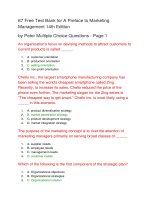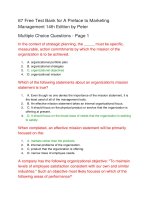TEST BANK microbiology a systems approach cowan 3e chapter002
Bạn đang xem bản rút gọn của tài liệu. Xem và tải ngay bản đầy đủ của tài liệu tại đây (234.5 KB, 284 trang )
Chapter 002 The Chemistry of Biology
Multiple Choice Questions
1. Anything that occupies space and has mass is called
A. Atomi
c
B. Livin
g
C. Matt
er
D. Energ
y
E. Spac
e
2. The electrons of an atom are
A. Always equal to the number of neutrons in
an atom
B. Found in the
nucleus
C. Used to determine atomic
number
D. Positively
charged
E. Moving in pathways called
orbitals
3. The electrons of an atom are
A. Always equal to the number of
protons
B. Used to determine the atomic
weight
C. Carrying a positive
charge
D. Used to determine the atomic
number
E. Always in full
orbitals
4. All of the following pertain to the atom carbon-14 except
A. Has 6
protons
B. Has 6
electrons
C. Has 14
neutrons
D. Is an isotope of
carbon
E. All of the choices pertain to
carbon-14
5. The subatomic particles that surround the nucleus are the
A. Electron
s
B. Proton
s
C. Neutron
s
D. Protons and
neutrons
E. Protons and
electrons
6. Isotopes are atoms of the same element that differ in their
A. Neutron
number
B. Electron
number
C. Proton
number
D. Atomic
number
E. Chemical
properties
7. What is the maximum number of electrons in the second energy shell of an atom?
A. 2
B. 4
C. 8
D. 1
8
E. 3
2
8. What is the maximum number of electrons in the first energy shell of an atom?
A. 2
B. 4
C. 8
D. 1
8
E. 3
2
9. Protons and neutrons make up the atom's central core referred to as its
A. Valence
number
B. Isotop
e
C. Nucleu
s
D. Center of
gravity
E. None of the choices are
correct
10. The valence number is the
A. Number of
protons
B. Number of
neutrons
C. Atomic
weight
D. Number of inner most
electrons
E. Number of outer most
electrons
11. Two or more atoms bonded together are called a/an
A. Io
n
B. Isotop
e
C. Eleme
nt
D. Electroly
te
E. Molecul
e
12. What would be the valence number of electrons in the sulfur (S) atom?
A. 2
B. 6
C. 8
D. 1
6
E. 3
2
13. Polar molecules are composed of covalently bonded
A. Identical
atoms
B. Carbon
atoms
C. Ion
s
D. Atoms of different electro
negativity
E. Atoms of identical electro
negativity
14. Polar molecules
A. Have an equal charge
distribution
B. Have an unequal charge
distribution
C. Are insoluble in
water
D. Always contain
carbon
E. Always involve
oxygen
15. Covalent bonds
A. Result from losing
electrons
B. Are always
polar
C. Are always nonpolar
D. Result from sharing
electrons
E. Result from gaining
electrons
16. Cations are a(n)
A. Charged subatomic
particles
B. Atoms that have gained
electrons
C. Atoms that have gained
neutrons
D. Capable of forming ionic bonds with
anions
E. Atoms without
protons
17. A reaction where an electron is lost is called
A. Oxidatio
n
B. Reductio
n
C. Ionizatio
n
D. Decompositi
on
E. Dissoluti
on
18. An atom has gained an electron. It has been
A. Oxidize
d
B. Reduce
d
C. Ionize
d
D. Deionize
d
E. Neutraliz
ed
19. Ionic bonds
A. Result from sharing
electrons
B. Result from transferring
electrons
C. Results from like charge
attraction
D. Are the weakest chemical
bonds
E. Always involve
carbon
20. Hydrogen bonds
A. Result from attractive forces between molecules with polar
covalent bonds
B. Result from attractive forces between molecules with polar
ionic bonds
C. Result from attractive forces between molecules with non-polar
covalent bonds
D. Result from attractive forces between molecules with non-polar
ionic bonds
E. Are the strongest bonds between
molecules
21. Atoms that gain or lose electrons become charged particles called
A. Cation
s
B. Anion
s
C. Ion
s
D. Isotope
s
E. All of the choices are
correct
22. Substances that release ions when dissolved in water and conduct electricity are
A. Covale
nt
B. Nonpol
ar
C. Electron
s
D. Electrolyt
es
E. Solvent
s
23. Which of the following represents a synthesis reaction?
A. AB ® A +
B
B. A + B ®
AB
C. AB + XY ® AX +
BY
D. AB + XY « AX +
BY
E. None of the choices are
correct
24. Which of the following represents a reversible reaction?
A. AB ® A +
B
B. A + B ®
AB
C. AB + XY ® AX +
BY
D. AB + XY « AX +
BY
E. None of the choices are
correct
25. The important solvent associated with living things is
A. Carbon
dioxide
B. Sodium
chloride
C. Ethyl
alcohol
D. Benzen
e
E. Wate
r
26. Ionic compounds are
A. Hydrophob
ic
B. Hydrophil
ic
C. Are acidic in
solution
D. Are basic in
solution
E. Always form salts in
solution
27. A solution is composed of one or more substances called _____ that are uniformly
dispersed in a dissolving medium called a _____.
A. Solvent,
solute
B. Solute,
solvent
C. Neither solvent, solute nor solute,
solvent
D. Both solvent, solute and solute,
solvent
28. Which term does not belong in this list?
A. Lactic
acid
B. Vinega
r
C. Hydrogen ion
donor
D. PH
8
E. Acidi
c
29. A solution of pH 7 compared to a solution of pH 9
A. Is more
basic
B. Has no OHions
C. Has more H+
ions
D. Has a higher
pH
E. All of the choices are
correct
30. A solution of pH 7 compared to a solution of pH 9
A. 2 times more
acidic
B. 20 times more
acidic
C. 20 times more
basic
D. 100 times more
acidic
E. 100 times more
basic
31. Which of the following functional groups is mismatched to the organic compound?
A. Phosphatecarbohydrates
B. Sulfhydrylproteins
C. Aminoproteins
D. Hydroxylalcohols
E. Carboxyl-fatty
acids
32 Or
. ga
nic
ch
e
mi
cal
s
al
wa
ys
ha
ve
a
ba
sic
fra
m
ew
or
k
of
th
e
el
e
m
en
t
___
__
bo
nd
ed
to
ot
he
r
at
o
ms
.
A.
B.
C.
D.
E.
33 Mo
. st
bi
oc
he
mi
cal
m
ac
ro
m
ol
ec
ul
es
ar
e
po
ly
m
er
s,
wh
ich
ar
e
A.
B.
C.
D.
E.
34 All
. of
th
e
fol
lo
wi
ng
ar
e
m
on
os
ac
ch
ari
de
s
ex
ce
pt
A.
B.
C.
D.
E.
35 W
. hic
h
of
th
e
fol
lo
wi
ng
wo
ul
d
ha
ve
gl
yc
osi
dic
bo
nd
s?
A.
B.
C.
D.
E.
36 All
. of
th
e
fol
lo
wi
ng
ar
e
po
lys
ac
ch
ari
de
s
ex
ce
pt
A.
B.
C.
D.
E.
37 C6
. H12
O6
+
C6
H12
O6
®
C12
H22
O1
1
+
H2
O
re
pr
es
en
ts
A.
B.
C.
D.
E.
38 St
. ar
ch
is
th
e
pri
m
ar
y
st
or
ag
e
fo
od
for
all
of
th
e
fol
lo
wi
ng
ex
ce
pt
A.
B.
C.
D.
E.
39 All
. of
th
e
fol
lo
wi
ng
ar
e
lipi
ds
ex
ce
pt
A.
B.
C.
D.
E.









